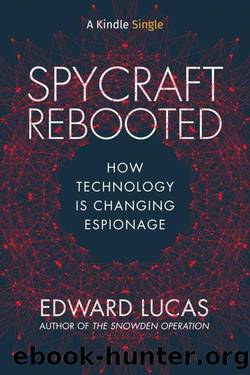Spycraft Rebooted: How Technology is Changing Espionage (Kindle Single) by Edward Lucas

Author:Edward Lucas [Lucas, Edward]
Language: eng
Format: epub
ISBN: 9781503957459
Publisher: Amazon Publishing
Published: 2018-03-06T05:00:00+00:00
* * *
7 It also, oddly, happens to be the name of a distinguished British journalist, now a friend and colleague of mine at the Economist.
Chapter Four: Painting by Numbers
In a way that would have astonished previous generations, digital technology allows the capture, storage, retrieval and processing of every feature of our physiology and behaviour. Elements of this date back decades; the recording and analysis of voices on telephone calls features in Alexander Solzhenitsynâs novel In the First Circle, set in Stalinâs Soviet Union. But in those days the systems relied on humans manually comparing âspectrographsââprintouts of voice patterns. The process is now automated from start to finish; it also includes not only voices, but also facial features, fingerprints, retina scans, gait, posture and even DNA.
As with mobile-phone technology, this makes it far harder to move around anonymously or inconspicuously. All over a modern city cameras are taking pictures of passers-by. Those pictures may be taken to help catch shoplifters or pickpockets. But in the hands of unscrupulous authorities they can be networked, so that every picture they take is instantly uploaded to a central database. These unblinking eyes never get tired, go on lunch breaks or get distracted. Even if some of them break down, others will capture your likeness the very next moment.
But the really powerful tool is not the collection of data, but the way the images are processed. Every picture which is uploaded to the database can be analysed to measure the relative position, size and shape of the cheekbones, ears, eyes, jaw and nose. The mathematics of this is complicated, including such arcane (to laypeople) techniques as âeigenfaces, linear discriminant analysis, elastic bunch graph-matching using the Fisherface algorithm, the hidden Markov model, the multilinear subspace learning using tensor representation, and neuronal motivated dynamic link matchingâ.ix But the results are simpleâand far more powerful than previous technologies such as fingerprints. The room for doubt is less, and the comparisons are made by computer, not by sharp-eyed individuals. Next-generation technology is still more powerful: it captures and stores a 3D picture of the targetâs face. It can also use facial expressions such as smiles and frowns, or even look at skin texture.
These systems are notâyetâfoolproof. They can be defeated by scarves and hats, by dim lighting and awkward angles, by bad weather and technical breakdowns. They may fail to match an image to the right record in the database, or match it incorrectly. This means that they are not wholly reliable for law-enforcement purposes. But from an intelligence point of view, that is not the point. They work at least some of the time, meaning that a risk-averse intelligence officer cannot be sure that he will escape their grasp.
In an authoritarian system, recordings from CCTV cameras create a huge, constantly expanding database which can be trawled for counter-intelligence purposes. The ability to search the public internet for images makes the searches even more powerful. A âreverse image searchâ gives anyone with an internet connection the chance to search for faces.
Download
This site does not store any files on its server. We only index and link to content provided by other sites. Please contact the content providers to delete copyright contents if any and email us, we'll remove relevant links or contents immediately.
| Cryptography | Encryption |
| Hacking | Network Security |
| Privacy & Online Safety | Security Certifications |
| Viruses |
Effective Threat Investigation for SOC Analysts by Yahia Mostafa;(7372)
Practical Memory Forensics by Svetlana Ostrovskaya & Oleg Skulkin(7092)
Machine Learning Security Principles by John Paul Mueller(7059)
Attacking and Exploiting Modern Web Applications by Simone Onofri & Donato Onofri(6718)
Operationalizing Threat Intelligence by Kyle Wilhoit & Joseph Opacki(6703)
Solidity Programming Essentials by Ritesh Modi(4517)
Microsoft 365 Security, Compliance, and Identity Administration by Peter Rising(4100)
Operationalizing Threat Intelligence by Joseph Opacki Kyle Wilhoit(3853)
Learn Computer Forensics - Second Edition by William Oettinger(3594)
Building a Next-Gen SOC with IBM QRadar: Accelerate your security operations and detect cyber threats effectively by Ashish M Kothekar(3563)
Future Crimes by Marc Goodman(3519)
Blockchain Basics by Daniel Drescher(3493)
Mastering Azure Security by Mustafa Toroman and Tom Janetscheck(3470)
Mastering Python for Networking and Security by José Manuel Ortega(3449)
Incident Response with Threat Intelligence by Roberto Martínez(3330)
The Code Book by Simon Singh(3070)
Mastering Bitcoin: Programming the Open Blockchain by Andreas M. Antonopoulos(2980)
Mobile App Reverse Engineering by Abhinav Mishra(2956)
From CIA to APT: An Introduction to Cyber Security by Edward G. Amoroso & Matthew E. Amoroso(2856)
